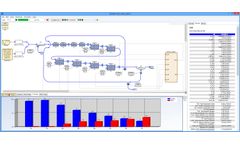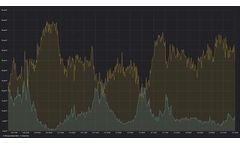Environmental Industry Software
-
Showcasebased in POLAND
X-Scale Belt is designed to register excavating and loading of bulk materials in such plants like: aggregate mines, gravel pits, cement works. X-Scale Belt may simultaneously operate numerous scales. The software can be adjusted to any type of ...
-
Showcasebased in USA
In addition to our Visual Hydraulics and Visual Water Designer modeling software packages, Innovative Hydraulics also provides custom hydraulic model development and advanced Computational Fluid Dynamics (CFD) modeling. We have created specialty models for a variety of clients and have used our CFD modeling capabilities to analyze various unique flow ...
-
Showcasebased in CANADA
SIMBA#water is a process simulator for modeling, simulation, optimization, and management of wastewater treatment plants and beyond. It provides process simulation capabilities for sewers, wastewater treatment plants, and ...
-
PremiumManufactured by LNI Swissgasbased in SWITZERLAND
The GasCal software allows the remote configuration, management and use of Sonimix devices from a remote PC. It simplifies operations done on gas monitors by the automation of routines and makes processes such as linearization, repeatability or reproductibility very easy to ...
-
PremiumManufactured by Metrohm AGbased in SWITZERLAND
Control your DropSens Potentiostats/ Galvanostats with an easy-to-use, intuitive software: DropView. This software covers all tasks from measurement setup, data acquisition to data handling, processing, and ...
-
Premiumbased in USA
Visual Hydraulics is a state of the art, flexible modeling tool. It is used primarily for modeling the hydraulic characteristics of water and wastewater treatment plants, and is capable of analyzing entire hydraulic profiles. The software follows the traditional method for analyzing water surface profiles: a downstream control point is selected, and the hydraulic profile is then determined ...
-
PremiumManufactured by Mobiltex Data Ltdbased in CANADA
This app is for configuring the corTalk® RMU3 (Remote Monitoring Unit 3) with a Bluetooth configuration interface. Both the RBT1 or RMU123PGM are compatible. They both function as a complete RMU3 programming interface but only requires the Bluetooth connection of your phone to ...
-
PremiumManufactured by Analytik Jena - an EndressHauser Companybased in GERMANY
Destination Lab Automation stands as a milestone for liquid handling and lab automation because we add substance to all the talk about the potential of lab automation for the pharmaceutical and life science industries. With strong customer focus and deep market experience, Analytik Jena with its CyBio product line is a leading brand for high quality liquid handling and automation technologies. ...
-
PremiumManufactured by Inertial Labs, Inc.based in USA
Engineered for partners and resellers in the remote sensing industry, PCMaster is the LiDAR point cloud generation software for Inertial Labs’ breakthrough LiDAR Remote Sensing Payload Instrument, ...
-
Premiumbased in UNITED KINGDOM
The Model Evaluation Toolkit is a free toolkit for evaluating local and regional air quality forecasting ...
-
PremiumManufactured by Metrohm AGbased in SWITZERLAND
With this in mind, we have developed an analytical software that makes your experience and your work as smooth, easy, and intuitive as it gets. Discover the OMNIS ...
-
PremiumManufactured by Mobiltex Data Ltdbased in CANADA
This app is for configuring the corTalk® RMU2 (Remote Monitoring Unit 2) with a Bluetooth configuration interface. Both the RBT1 or RMU123PGM are compatible. They both function as a complete RMU2 programming interface but only requires the Bluetooth connection of your phone to ...
-
PremiumManufactured by KISTERSbased in GERMANY
Software for the classification and labelling of hazardous substances, preparation of safety data sheets, preparation of transport documents for all modes of transport and detailed information on hazardous materials and dangerous ...
-
PremiumManufactured by OPSIS ABbased in SWEDEN
You probably want to have your data from your air quality monitoring network or your emissions monitoring instruments at our fingertips, or more precisely on a screen in front of you. However, to get it there in a safe and secure way can be a challenge. To configure and operate a computer network for this task with servers, switches, firewalls, authentication, authorization, backups, updates, ...
-
PremiumManufactured by Mobiltex Data Ltdbased in CANADA
LTE Swap facilitates the upgrade process from 2G or 3G cellular technology Mobiltex RMU2 and RMU3 units to corresponding pre-purchased LTE units. It helps transfer all settings and configuration data which allows for a quick and simple swap process. If needed, it will also update the firmware of the unit it is connecting to before completing the swap process to ensure that the most up to date ...
-
PremiumManufactured by KISTERSbased in GERMANY
Customisable and robust data management systems to fit your needs. Understanding the historic and current state of our environment is paramount to dealing with the many challenges we face due to climate change, population growth, and regulatory and market pressures. Whether weather, soil, water, or ecological data – they must be properly and reliably collected, managed, and processed for ...
-
Premiumbased in CANADA
IRAP-h View is a user-friendly graphical interface for conducting a comprehensive multi-pathway human health risk assessment. It simultaneously calculates risk values for multiple chemicals, from multiple sources, at multiple exposure locations. Regardless of experience, risk assessors, trial burn planners, permit writers, and toxicologists can readily produce expert results and professional ...
-
PremiumManufactured by Inertial Labs, Inc.based in USA
PCPainter is Inertial Labs’ .las colorization software. This is done by projecting images from the integrated camera over the .las file. As a result, each point is colorized to reflect the images captured in ...
-
Premiumbased in CANADA
Hassle-free access to your install-base's data for equipment performance management. Go digital and differentiate your products from your ...
-
PremiumManufactured by DILO Armaturen und Anlagen GmbHbased in GERMANY
The "SF6 Monitoring Manager" is a database-driven software tool for the intelligent stock management of SF6 gas in switchgear production and for utility companies. All DILO weighing systems and gas refilling devices as well as mass flowmeters with digital interfaces can be connected to the database. The user-friendly software makes it possible to monitor and log the SF6 stock – even across ...
Need help finding the right suppliers? Try XPRT Sourcing. Let the XPRTs do the work for you



















